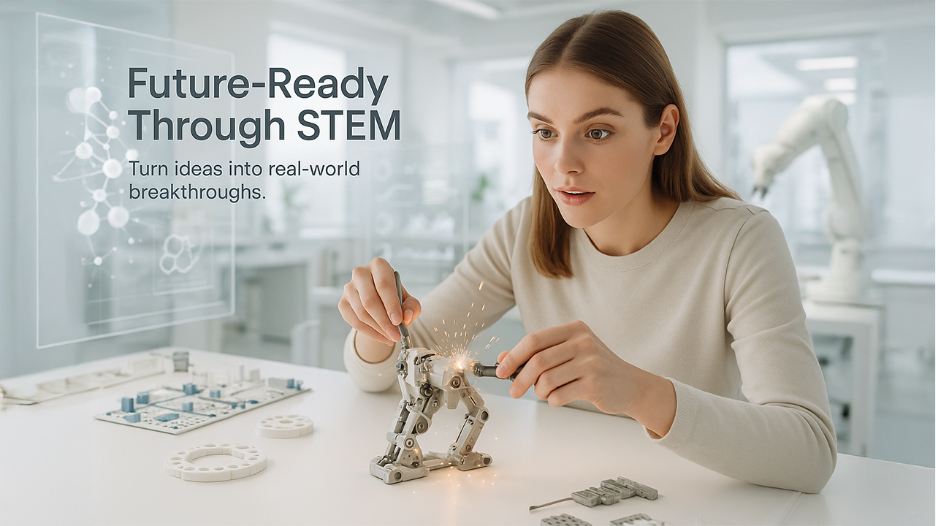The world is changing faster than most classrooms can keep up with. Jobs are evolving, new industries are emerging, and technology is rewriting how people work. In this fast-paced environment,
The world is changing faster than most classrooms can keep up with. Jobs are evolving, new industries are emerging, and technology is rewriting how people work. In this fast-paced environment, one thing is clear—STEM education is the foundation of every future-proof career.
STEM stands for science, technology, engineering, and math. These subjects form the language of progress. Whether someone wants to work in healthcare, renewable energy, software, or business analytics, STEM skills open the door.
Why STEM Is No Longer Optional
The job market today rewards problem solvers and innovators. The World Economic Forum predicts that STEM-related jobs will grow by 10% between 2022 and 2032, while non-STEM jobs will grow by only 2%. That gap shows how essential these skills have become.
STEM is no longer limited to labs or tech companies. A graphic designer uses coding tools. A farmer analyzes soil data. A doctor relies on algorithms to track patient health.
One engineering graduate put it simply: “My first job wasn’t what I studied for—but everything I learned in physics, coding, and math helped me figure things out fast.”
This is what makes STEM education powerful. It trains the mind to adapt.
What STEM Really Teaches
Curiosity and Experimentation
STEM classes don’t just teach formulas. They teach students how to ask questions and test ideas. In an unpredictable job market, curiosity is gold. The ability to analyze, build, and improve is what keeps workers valuable.
A student who can experiment confidently will never be left behind. They know how to break down problems and rebuild them into something better.
Critical Thinking
In STEM, there’s no single path to an answer. That’s what makes it so valuable. Students learn to think critically—compare evidence, weigh outcomes, and make decisions under pressure. These habits apply to any career, from data analysis to marketing strategy.
Collaboration and Communication
Modern STEM work happens in teams. Engineers need designers. Programmers need project managers. Biologists work with statisticians. The collaboration teaches people how to explain complex ideas clearly, which is one of the most underrated skills in any profession.
STEM Across Every Industry
Technology and Automation
Every sector is becoming more automated. From finance to construction, companies need workers who can manage machines, write code, and interpret data.
Jobs like data scientist, AI engineer, and cybersecurity analyst didn’t exist a few years ago. Now they’re among the highest-paying and most in-demand roles worldwide.
Healthcare and Biotechnology
STEM is transforming healthcare too. Biotech research, genetic testing, and artificial intelligence are creating new treatments and tools. The Bureau of Labor Statistics projects a 13% growth in healthcare-related STEM jobs by 2031.
Sustainability and Clean Energy
Climate change is creating entirely new industries around renewable energy, green engineering, and sustainable design. STEM graduates will lead the shift toward solar, wind, and smart energy systems.
A renewable energy student once said, “Learning about environmental engineering gave me a way to turn my worry about climate change into something useful.”
That’s what STEM does—it converts fear of the future into the power to change it.
Why Creativity Is Key in STEM
STEM isn’t just about logic. It’s also about imagination. Solving complex problems requires creative thinking. The best engineers think like artists, and the best scientists think like inventors.
At Pures College of Technology, instructors emphasize this balance. They encourage students to use both logic and creativity when approaching a problem. That combination produces the kind of innovation industries crave.
One faculty member said, “We train students to work across boundaries. A coder might end up collaborating with a designer or a biologist. That’s where the big ideas happen.”
This mix of disciplines—often called STEAM when art is included—teaches students to think differently. It’s how breakthroughs are born.
Actionable Solutions for Colleges
1. Update Curriculum Constantly
Technology evolves too fast for static courses. Colleges must update their STEM programs yearly to keep pace. Partnering with companies can help identify the newest tools and methods.
2. Make Hands-On Learning Standard
Technology evolves too fast for static courses. Colleges must update their STEM programs yearly to keep pace. Partnering with companies can help identify the newest tools and methods. Integrating AI in Education is becoming crucial, as these technologies can personalize learning experiences and help students master complex STEM concepts more effectively.
3. Build Industry Partnerships
Colleges that collaborate with businesses give students a clearer view of how STEM is used outside the classroom. These partnerships often lead to internships and job offers.
4. Encourage Entrepreneurship
STEM skills are perfect for innovation. Colleges should create incubators and startup labs that help students turn projects into real businesses. This builds independence and problem-solving confidence.
5. Focus on Soft Skills
Even the most talented engineer needs communication skills. Teaching teamwork, leadership, and adaptability makes graduates more employable and resilient.
Recommendations for Students
Learn the Basics Well
Every complex skill comes from strong basics. Master math, science, and coding fundamentals. They’ll support every career change you make.
Practice Problem-Solving
Look for puzzles and challenges. Hackathons, coding bootcamps, and maker clubs are great ways to sharpen your skills.
Stay Curious
New tools appear every year. Keep learning outside of class—watch tutorials, read, and experiment. Curiosity is the best investment you can make in your career.
Build Something
Don’t just study. Build. Create a website, an app, a robot, or a project that solves a problem you care about. Every project is proof that you can apply your skills in the real world.
As one student who built a recycling-sorting robot said, “I didn’t build it for a grade. I built it because I wanted to see if I could make something work.”
That’s the mindset that turns STEM students into innovators.
The Long-Term Impact of STEM Education
STEM isn’t just about careers—it’s about progress. It shapes how societies solve problems. It builds confidence in students who learn to see the world as something they can understand and improve.
Employers know this. They value people who can think analytically, experiment, and adapt. Those are the people who stay relevant no matter how industries evolve.
The next wave of jobs may not exist yet, but one thing is certain: they’ll all rely on STEM thinking.
STEM is how we build resilience, creativity, and opportunity into every career path. It’s how today’s students become tomorrow’s innovators. And it’s
Respond to this article with emojis






